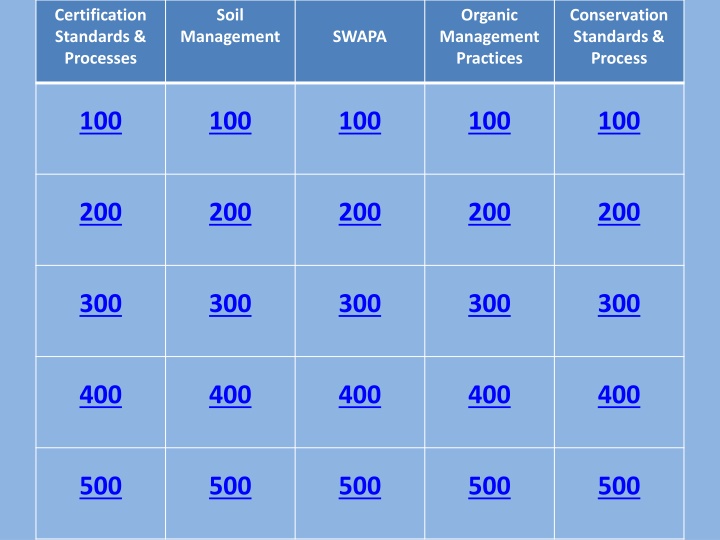
Organic Farm Certification Standards and Processes
Explore the intricate processes and practices involved in maintaining organic standards on a farm, including the importance of periodic inspections, the timeline for achieving organic certification, the role of accredited certifying agencies, the need for buffer zones, and essential components of an Organic System Plan. Learn about management practices, production inputs, monitoring methods, record-keeping systems, and contamination prevention strategies crucial for organic farming compliance.
Download Presentation

Please find below an Image/Link to download the presentation.
The content on the website is provided AS IS for your information and personal use only. It may not be sold, licensed, or shared on other websites without obtaining consent from the author. If you encounter any issues during the download, it is possible that the publisher has removed the file from their server.
You are allowed to download the files provided on this website for personal or commercial use, subject to the condition that they are used lawfully. All files are the property of their respective owners.
The content on the website is provided AS IS for your information and personal use only. It may not be sold, licensed, or shared on other websites without obtaining consent from the author.
E N D
Presentation Transcript
Certification Standards & Processes Soil Organic Management Practices Conservation Standards & Process Management SWAPA 100 100 100 100 100 200 200 200 200 200 300 300 300 300 300 400 400 400 400 400 500 500 500 500 500
How often an organic farm is inspected to ensure compliance with National Organic Standards
What is Annually? logo.png
The minimum time between last application of prohibited substances and harvest on an organic farm to achieve organic certification
What is three years? logo.png
Organizations who verify a farm is complying with USDA s National Organic Standards
What are Accredited Certifying Agencies? They can be either state, county or private logo.png
If there is a risk of contamination by prohibited substances from adjacent land, your certification agency will want you to establish this on your farm
What is a buffer zone or boundary zone? logo.png
These three components must be included in an Organic System Plan
What are management practices and procedures, list of production inputs, monitoring practices, record- keeping systems, practices to prevent contamination (any three of these) logo.png
This recognized system of practices can increase soil organic matter and reduce nitrate leaching
What is Organic Agriculture? logo.png
True or False Unlike conventionally managed systems, organic production restricts when un-composted manure can be applied to food crops
What is True? logo.png
This cropping management practice is required under the organic standards
What is crop rotation? logo.png
Three techniques organic growers can use to manage crop nutrients and soil fertility
What are crop rotations, cover crops and application of (natural) plant or animal materials (green or animal manures, blood meal, feather meal, compost, etc.)? logo.png
According to the National Organic Standards, this damaging situation must be minimized in organically managed systems
What is soil erosion? logo.png
How many resource concerns (SWAPA) do NRCS planners address? logo.png
The desired condition of a resource.
What is Quality Criteria? logo.png
What is Tolerable Soil Loss? logo.png
Temperature can be a concern for this resource.
What is water or air? logo.png
Stream Visual Assessment Protocol (SVAP)
What does NRCS use to assess stream conditions? logo.png
This is a farmers first approach to organic pest management
What is prevention? (also acceptable what is good soil management?) logo.png
Providing sources of pollen and nectar will encourage higher populations of these
What are beneficial insects? logo.png
This practice is required in organically managed systems and is also a cost-share practice under NRCS
What is crop rotation? logo.png
This new tool/technique may allow more organic growers to utilize no- till and reduce weed problems
What is a Roller-Crimper? logo.png
Five weed management options available to organic growers
What are cultivation, mowing, grazing, hand weeding, flaming and mulching? logo.png
How many steps are there in the NRCS Conservation Planning Process? logo.png
Where does NRCS store its technical information? logo.png
These must be needed, feasible and practical
What are recommended practice alternatives? logo.png
This type of conservation plan addresses all resource concerns found on a planning unit
What is a Resource Management System Plan? logo.png
A collection of maps, notes, inventory & assessment data, and documents related to landowner decisions
